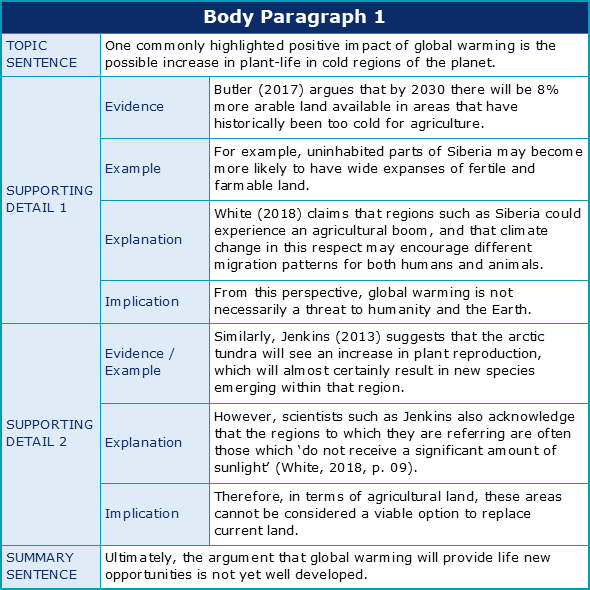What are supporting details in a body paragraph?

This is the first of three chapters about Supporting Details. To complete this reader, read each chapter carefully and then unlock and complete our materials to check your understanding.
– Review the various body-paragraph elements which are useful in academic essays
– Explore the importance of supporting details
– Introduce the various types of supporting details, such as evidence, examples and explanations
Before you begin reading...
-
video and audio texts
-
knowledge checks and quizzes
-
skills practices, tasks and assignments
Chapter 1

The body of an essay is its most important section, and the trickiest part to get right. While the introduction and the conclusion can follow a fairly straightforward pattern, for the body section there is more variation in a how a student can structure their writing to create an effective essay. Thankfully, whether you’re writing a compare and contrast, evaluative or problem-solution essay, there are still a number of key body-paragraph elements you should try to include to help guarantee high grades – and the most important of these are called supporting details.
In this short three-chapter reader, we explore the concept of supporting details (Chapter 1), the different types of supporting detail on offer (Chapter 2) and why providing implications in your support is so important (Chapter 3). For a more general introduction to body sections, students may wish to first visit our short reader about body paragraphs.
Body-Section Elements
There are three key essay elements within a body paragraph that students should make sure they’ve included before submitting their assignment. These are topic sentences, supporting details and summary-transition sentences. An example of each element is provided for you below, taken from our example problem-solution essay about air pollution. Read these excerpts carefully and see if you can guess the purpose of each element:



Were you able to determine the following purpose for each element?
Topic Sentence = inform the reader of the main idea of the paragraph (which should connect with the introductory thesis, i.e., the focus of the whole essay)
Supporting detail = provide support for the main idea(s) stated in the topic sentence, usually by using evidence (facts and statistics), examples and explanations
Summary-transition sentence = remind the reader of the main idea being explored in the paragraph, summarise the key arguments or findings, or transition (move smoothly) from the main idea of this paragraph to the main idea of the next
The Importance of Supporting Details
Where topic and summary sentences take up only about 20% of a body paragraph, the remaining 80% of that paragraph should be dedicated to an exploration of the topic-sentence’s main idea(s). This is done through the inclusion of a variety of convincing and related supporting details. Because the key aim of an academic essay is to be persuasive, logical and concise, persuading your reader of your opinion or stance will require the inclusion and explanation of a number of sources and source-based experiments and examples in the form of supporting details.

Whenever you include statistics or facts, or case studies or historical events, or when you explain or contextualise such evidence, each of these sentences forms part of a supporting detail, and without such details your essay would have very little substance. That essay would not convince your reader of your viewpoint, and it would not receive a high grade.
Supporting-Detail Elements
Supporting details have a few different elements that students are encouraged to include, namely evidence, examples, explanation and implications. However, depending on the essay type being written, sentences which are dedicated to providing solutions to problems or to describing the effects caused by a particular situation may also be required.
To see examples of these elements, let’s look at the first body paragraph of an example evaluative essay which answers the question “Global warming is a relatively new phenomenon that may be providing more advantages than disadvantages for the future of healthy ecosystems on this planet. Discuss.”

By studying this table carefully, you should be able to see how a body paragraph may have multiple supporting details (this paragraph has two) and how each supporting detail may be comprised of a number of elements, such as evidence, examples and explanation. For a closer look at how these supporting-detail elements function, and for guidance on how to include them in your own academic essay, continue reading on to Chapter 2 of this short reader.
To reference this reader:
Academic Marker (2022) Supporting Details. Available at: https://academicmarker.com/essay-writing/body-paragraphs/supporting-details/ (Accessed: Date Month Year).
Downloadables
Once you’ve completed all three chapters in this short reader about Supporting Details, you might then wish to download our Chapter Worksheets to check your progress or print for your students. These professional PDF worksheets can be easily accessed for only a few Academic Marks.
Chapter 1 explores the topic: What are supporting details in a body paragraph? Our Chapter 1 Worksheet (containing guidance, activities and answer keys) can be accessed here at the click of a button.
Chapter 2 explores the topic: How can I add evidence, examples and explanation? Our Chapter 2 Worksheet (containing guidance, activities and answer keys) can be accessed here at the click of a button.
Chapter 3 explores the topic: Why are implications important in body support? Our Chapter 3 Worksheet (containing guidance, activities and answer keys) can be accessed here at the click of a button.
To save yourself 2 Marks, click on the button below to gain unlimited access to all of our Supporting Details Chapter Worksheets. This All-in-1 Pack includes every chapter, activity and answer key related this topic in one handy and professional PDF.
Collect Academic Marks
-
100 Marks for joining
-
25 Marks for daily e-learning
-
100-200 for feedback/testimonials
-
100-500 for referring your colleages/friends